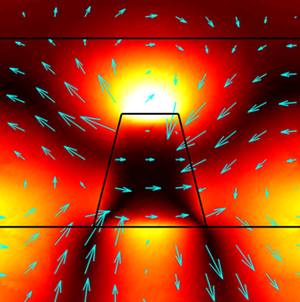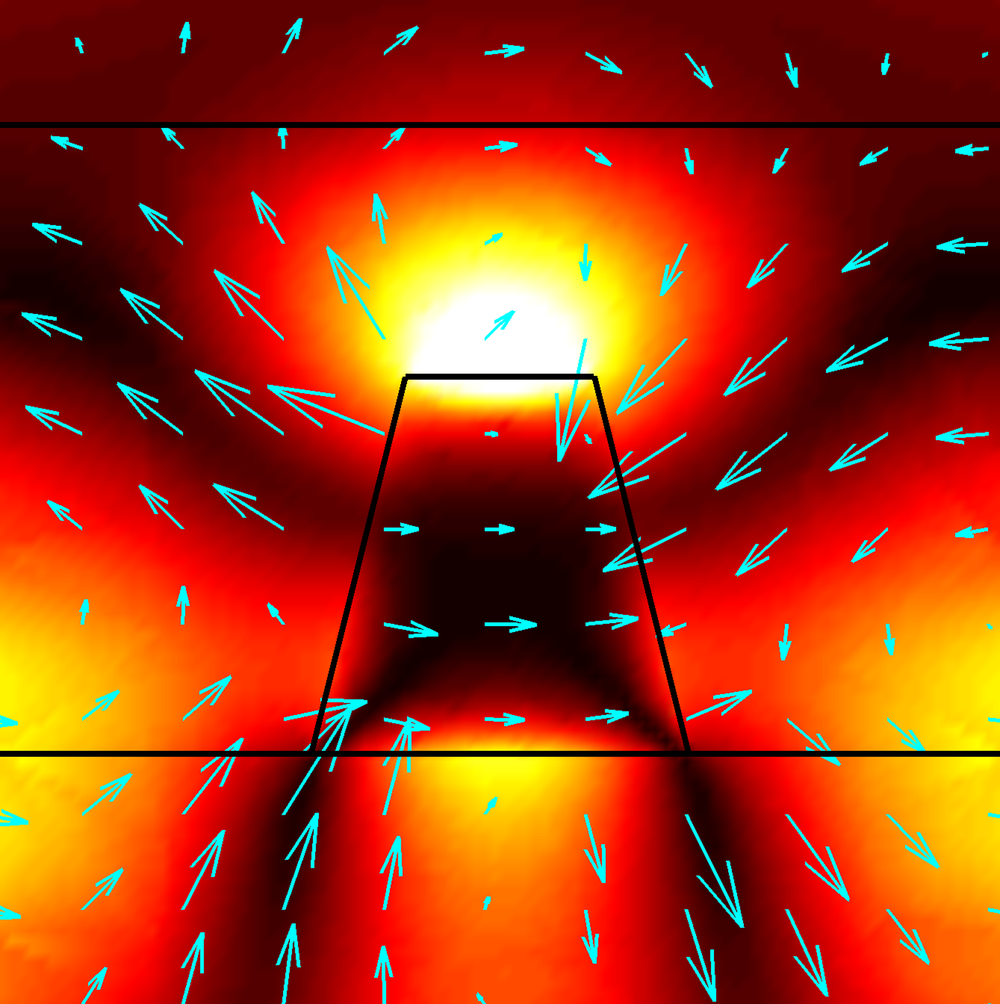Nanopyramids’ Color Depends on Viewing Direction
Engineered structures with complex geometries on scales less than the wavelength of light can have a variety of unusual optical properties. Now researchers have designed a new structure, based on an array of tiny aluminum pyramids, that preferentially emits light of different wavelengths in different directions. The new structure might be of value, the researchers suggest, in improving the directionality of microscopic light-emitting devices.
Many materials become magnetic in response to an applied magnetic field and can also produce an equivalent electric response to an electric field. 30 years ago, Milton Kerker and his colleagues at what is now Clarkson University in Potsdam, New York, analyzed theoretically the behavior of light waves hitting a sphere made of some hypothetical material with equal electric and magnetic responses, or polarizabilities [1]. For a sphere smaller than the light’s wavelength, they found that scattering in the forward direction would completely vanish, while backward scattering would be strong. Jaime Gómez Rivas of the Foundation for Fundamental Research on Matter Institute for Atomic and Molecular Physics (FOM Institute AMOLF) and the Eindhoven Institute of Technology in the Netherlands, and his colleagues, wanted to use this effect to manipulate light in new ways.
For natural materials, the magnetic polarizability is much weaker than the electric polarizability, but the team realized that they could tweak the electric and magnetic behavior of a nanoparticle by adjusting its shape. The shape and size influence such a particle’s interaction with an external field and can dramatically increase its magnetic polarizability.
After calculating the properties of various shapes, they settled on a truncated aluminum pyramid with a square base, 150 nanometers (nm) across, tapering to a 70-nm-wide flat top at a height of 150nm. The response of this object to an electromagnetic wave is complex, but team member Said Rodriguez, now at the CNRS Laboratory for Photonics and Nanostructures in Paris, explains that for red light traveling along the vertical axis of the pyramid, the particle has magnetic polarizability almost equal to its electric polarizability.
The researchers fabricated a square lattice of nanopyramids, spaced 400nm apart, on a silica base, and coated the device with a layer of polystyrene infused with an organic dye. The dye was luminescent, emitting red light when excited by a blue laser.
The team first measured how well the array transmitted red light in the wavelength range 550 to 700nm. In these tests the dye played no role. At 660nm, the array was almost totally opaque, because at this wavelength each aluminum nanopyramid efficiently absorbs light and converts it into a localized surface oscillation of electrons known as a plasmon. At about 600nm, the array was nearly transparent: here, the collective scattering of light by the lattice of pyramids gives rise to a standing electromagnetic wave in the plane of the lattice that facilitates the transmission of light. Finally, at about 580nm, they found that transmission decreased again: at this wavelength, interaction between the plasmon resonance and lattice scattering gives rise to a surface lattice resonance that enhances the conversion of light energy into electron oscillations.
The researchers then shone blue light onto the array to excite red light from the dye molecules. In line with Kerker’s argument, the pyramids steered this light asymmetrically away from the lattice, in a way that was magnified by the plasmon resonance and lattice scattering. Light emerging from the top of the array was more intense at 660nm, the plasmon resonance, and suppressed at 580nm, the surface lattice resonance. Light emerging downward showed the opposite pattern. In other words, Rodriguez says, the array emits a slightly different color depending on which side you look at. Numerical simulations of wave patterns in the array confirmed the team’s interpretation of this behavior.
Andrea Alù of the University of Texas, Austin, says that the demonstration of the difference in forward and backward radiation is “good work” and likens the arrangement to the optical equivalent of a directional radio antenna. Rodriguez says that such an array could be a useful addition to light-emitting diodes (LEDs), for example, because it would increase the amount of light emitted in the forward direction. Both Alù and Bill Barnes, of the University of Exeter, UK, caution, however, that the complexity of the structure may be an impediment to practical commercial applications.
This research is published in Physical Review Letters.
–David Lindley
David Lindley is a freelance science writer, now retired. His most recent book is The Dream Universe: How Fundamental Physics Lost Its Way (Penguin Random House, 2020).
References
- M. Kerker, D.-S. Wang, and C.L. Giles, “Electromagnetic Scattering by Magnetic Spheres,” J. Opt. Soc. Am. 73, 765 (1983)





